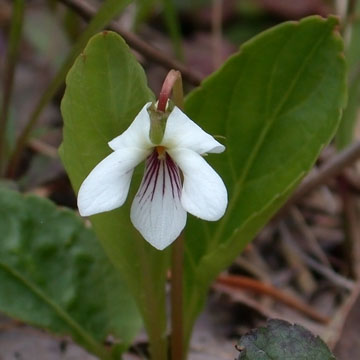

Viola primulifolia - (image 1 of 3)
Taxonomy
Family: Violaceae
Habitat
Mixed swamp forests, white cedar swamps, often in Sphagnum, sometimes in sandy barrens.
Associates
Distribution
Central and eastern United States. The variety occidentalis occurs in northwestern CA and southwestern OR.
Morphology
Acaulescent perennial from a thick or slender fleshy rhizome, also stoloniferous. Leaf blades elliptic to widely ovate, broadly cordate to attenuate at the base, surfaces sparsely pubescent or rarely glabrous, margins crenate-serrate, the teeth sometimes glandular (visible under magnification), acute to rounded at the apex. Sepals lanceolate to ovate, auricles 1-2 mm; petals white, lower three purple-veined, the laterals bearded or beardless, spur petal 9-14 mm, spur white, gibbous, 1-2 mm; capsule ellipsoid (5-)8-9 mm, glabrous; seeds beige to bronze, 1.5-2 mm.
Notes
Flowers late April to June
Wetland indicator: FAC, FACW
Some authors have considered this species to be a hybrid of V. lanceolata and V. macloskeyi though the latter does not occur throughout much of the range of V. primulifolia.
References
Haines, A. 2011.
Flora Novae Angliae: a manual for the identification of native and naturalized
higher vascular plants of New England. Yale University Press, New Haven, CT.
Little, R.J. and
L.E. McKinney. 2015. Viola. In: Flora of North America North of
Mexico, Vol. 6. Oxford University Press, New York and Oxford.
USDA, NRCS. 2002. The PLANTS Database, Version 3.5 (http://plants.usda.gov).
National Plant Data Center, Baton Rouge, LA 70874-4490 USA.
|
Michael Hough © 2017 |